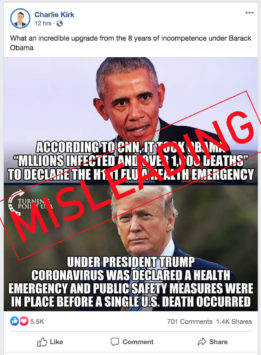Quick Take
Full Story
We’ve previously dissected President Donald Trump’s faulty comparisons between his response to the novel coronavirus pandemic and former President Barack Obama’s handling of the H1N1 “swine flu” pandemic.
But misleading comparisons persist, and recent social media posts twist the facts about the timing of emergency declarations for the two outbreaks.

“[I]t took Obama ‘millions infected and over 1,000 deaths’ to declare the H1N1 flu a health emergency,” read a March 29 meme on the verified page of Charlie Kirk, the founder of the conservative youth organization Turning Point USA. But under Trump, “coronavirus was declared a health emergency and public safety measures were in place before a single U.S. death occurred.”
That’s wrong. Both the Obama and Trump administrations declared public health emergencies before the first reported deaths relating to the novel coronavirus and H1N1.
The meme actually compares the point at which Trump declared a public health emergency and the point at which Obama issued a national emergency — two distinct processes. A spokesman for Turning Point USA acknowledged in an email that its “social media team confused the two different types of emergency declarations.”
A public health emergency, declared by the secretary of Department of Health and Human Services, gives the federal government and states certain flexibilities, such as temporarily reassigning personnel, to respond to a major health issue. A national emergency declared by the president is more substantial and can provide access to significant sums of federal money and resources.
Turning Point USA deleted the image after our inquiry, but other posts of the same meme are still on Facebook, and the claim also migrated to Twitter (and back to Facebook).
Here’s an actual (albeit abridged) timeline for the emergency declarations for each pandemic.
Emergency Declarations for H1N1
- The first U.S. infection of the novel type of influenza was identified in California on April 15, 2009.
- On April 25, the World Health Organization declared a public health emergency of international concern.
- The next day, the U.S. Department of Health and Human Services declared a public health emergency. (It was repeatedly renewed.)
- The U.S. Centers for Disease Control and Prevention reported the first fatality from the outbreak days later, on April 29.
- WHO declared H1N1 a pandemic on June 11.
- By Oct. 5, an H1N1 vaccine was ready and the first doses were given in the U.S.
- Obama weeks later declared a national emergency on Oct. 24, 2009. The CDC director, Dr. Thomas Frieden, said at the time that millions of people had been infected in the U.S. and more than 1,000 had died.
Emergency Declarations for COVID-19
- The CDC confirmed the first case of the novel coronavirus in the U.S., in Washington state, on Jan. 21.
- WHO declared a global public health emergency of international concern days later on Jan. 30.
- The next day, on Jan. 31, HHS declared a public health emergency for the U.S. in response to the novel coronavirus, which causes the COVID-19 disease.
- Weeks later, on Feb. 29, the first U.S. death attributed to the virus was reported.
- WHO declared COVID-19 a pandemic on March 11.
- On March 13, Trump declared a national emergency. As of March 12, there had been 40 reported deaths in the U.S.
In addition to being wrong, the posts misleadingly suggest that while Trump took decisive action on the coronavirus outbreak and put “public safety measures” in place, Obama failed to do the same when it came to H1N1.
As we’ve previously explained, the CDC began releasing antiviral drugs to treat the H1N1 flu on April 26, the same day of Obama’s public health emergency declaration, and two days later the FDA approved a new CDC test for the disease. By April 30, Obama formally requested $1.5 billion from Congress to address the outbreak (the Obama administration later asked for nearly $9 billion). And a vaccine was made available in about six months.
More than 12,000 people are estimated to have died from H1N1 between April 2009 and April 2010, according to the CDC. There have been more than 3,400 deaths attributed to COVID-19 in the U.S. as of early March 31.
Editor’s note: FactCheck.org is one of several organizations working with Facebook to debunk misinformation shared on social media. Our previous stories can be found here.
Sources
“2009 H1N1 Flu Outbreak: Determination that a Public Health Emergency Exists.” Assistant Secretary for Preparedness and Response, U.S. Department of Health and Human Services. 19 Apr 2013.
“2009 H1N1 Pandemic Timeline.” U.S. Centers for Disease Control and Prevention. 8 May 2019.
“CDC, Washington State Report First COVID-19 Death.” U.S. Centers for Disease Control and Prevention. 29 Feb 2020.
“Coronavirus COVID-19 Global Cases.” Center for Systems Science and Engineering, Johns Hopkins University. Accessed 31 Mar 2020.
“Declaration of a National Emergency with Respect to the 2009 H1N1 Influenza Pandemic.” Obama White House. 24 Oct 2009.
“First Travel-related Case of 2019 Novel Coronavirus Detected in United States.” U.S. Centers for Disease Control and Prevention. 21 Jan 2020.
“H1N1 Flu Daily Update: April 29, 2009.” U.S. Centers for Disease Control and Prevention. 29 Apr 2009.
Lister, Sarah A. and C. Stephen Redhead. “The 2009 Influenza Pandemic: An Overview.” Congressional Research Service. 10 Sep 2009.
McDonald, Jessica and Lori Robertson. “Trump’s H1N1 Swine Flu Pandemic Spin.” FactCheck.org. 13 Mar 2020.
“Press Briefing Transcripts | Weekly 2009 H1N1 Flu Media Briefing.” U.S. Centers for Disease Control and Prevention. 23 Oct 2009.
“Proclamation on Declaring a National Emergency Concerning the Novel Coronavirus Disease (COVID-19) Outbreak.” White House. 13 Mar 2020.
“Secretary Azar Declares Public Health Emergency for United States for 2019 Novel Coronavirus.” U.S. Department of Health and Human Services. 31 Jan 2020.
“Statement on the second meeting of the International Health Regulations (2005) Emergency Committee regarding the outbreak of novel coronavirus (2019-nCoV).” World Health Organization. 30 Jan 2020.